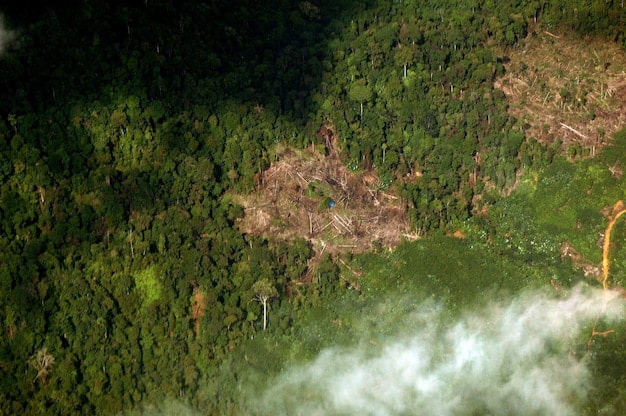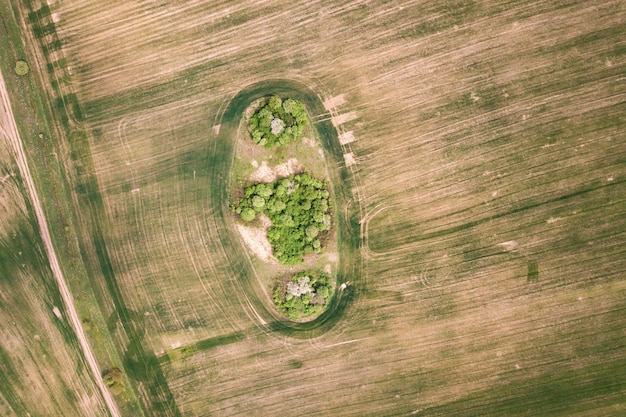Amazon Deforestation: How US Imports Fuel Climate Change

Deforestation rates in the Amazon rainforest are alarmingly high, and a significant driver is the demand for agricultural products, particularly beef and soy, in countries like the US, exacerbating climate change by releasing stored carbon into the atmosphere.
The Amazon rainforest, a vital organ of our planet, is under siege. Rising deforestation rates in the Amazon: What’s the connection to climate change and US imports? This complex issue touches on environmental policy, global trade, and the choices we make as consumers.
Understanding Amazon Deforestation Rates
To grasp the gravity of the situation, it’s crucial to understand the recent trends in Amazon deforestation. The numbers paint a sobering picture, with a demonstrable increase in forest loss over the past few years.
Recent Deforestation Trends
Over the past decade, deforestation rates in the Amazon have fluctuated, but a concerning upward trend has emerged recently. Understanding these trends is crucial for assessing the severity of the problem.
Key Factors Driving Deforestation
Several factors contribute to deforestation, including agricultural expansion, illegal logging, and mining activities. Identifying these key drivers is essential for effective intervention.
- Agricultural Expansion: The conversion of forest land for cattle ranching and soybean cultivation is a major driver.
- Illegal Logging: Unauthorized and unsustainable timber harvesting contributes significantly to forest loss.
- Mining Activities: Both legal and illegal mining operations clear large areas of forest and pollute the surrounding environment.
- Infrastructure Projects: Road construction and other development projects open up previously inaccessible areas, leading to increased deforestation.
In summary, understanding the scale and the drivers of deforestation is fundamental to addressing the issue effectively. Recent trends indicate an urgent need for action.

The Climate Change Connection
Deforestation in the Amazon has profound implications for climate change. The rainforest plays a vital role in regulating global climate patterns. A reduction in tree cover not only releases sequestered carbon but also disrupts regional and global weather systems.
The Amazon’s Role in Carbon Sequestration
The Amazon rainforest acts as a massive carbon sink, absorbing vast amounts of carbon dioxide from the atmosphere. When forests are cleared, this stored carbon is released, contributing to greenhouse gas emissions.
Impact on Global Climate Patterns
The Amazon influences rainfall patterns and temperatures far beyond its borders. Deforestation can lead to altered weather patterns, increased drought risk, and changes in regional and global climate.
- Reduced Rainfall: Deforestation decreases evapotranspiration, leading to less rainfall in the Amazon region.
- Increased Temperatures: Loss of forest cover contributes to higher local and regional temperatures.
- Disrupted Carbon Cycle: Deforestation disrupts the natural carbon cycle, increasing atmospheric carbon dioxide levels.
The connection between Amazon deforestation and climate change is undeniable. Protecting the rainforest is essential for mitigating global warming and maintaining the planet’s climate stability.
The US Import Connection: Beef and Soy
US imports, particularly beef and soy, play a significant role in driving deforestation in the Amazon. Understanding this connection can inform more sustainable consumption choices.
US Demand for Beef and Soy
The US is a major importer of beef and soy, both of which are significant drivers of deforestation in the Amazon. High demand incentivizes agricultural expansion at the expense of forest land.
How Imports Drive Deforestation
The demand for agricultural products like beef and soy incentivizes farmers to clear forest land for pasture and cultivation. This direct link between consumption and deforestation highlights the global nature of the problem.
Supply Chain Transparency
Lack of transparency throughout the supply chain makes it difficult to trace products back to their origin and ensure they are not linked to deforestation. This is a major obstacle to sustainable sourcing.
In conclusion, US imports of beef and soy contribute significantly to deforestation in the Amazon. Increasing supply chain transparency, understanding it and sustainable consumption practices are crucial for mitigating this impact.

The Role of US Policy and Regulation
US policies and regulations can play a crucial role in addressing deforestation. Implementing measures that promote sustainable sourcing and reduce demand for deforestation-linked products is essential.
Current US Policies on Deforestation
Existing US policies often lack specific provisions targeting deforestation linked to imported products. Strengthening these policies is necessary to address the issue effectively.
Potential Policy Improvements
Several policy improvements could help reduce the impact of US imports on Amazon deforestation. These include stricter sourcing requirements, trade agreements that prioritize environmental sustainability, and incentives for sustainable agriculture.
- Stricter Sourcing Requirements: Implementing regulations that require companies to ensure their products are not linked to deforestation.
- Trade Agreements: Negotiating trade agreements that prioritize environmental sustainability and include provisions to prevent deforestation.
- Incentives for Sustainable Agriculture: Providing financial and technical support for sustainable farming practices in the Amazon region.
Therefore, strengthening US policies and regulations is essential for reducing the impact of US imports on Amazon deforestation. This will require a multi-faceted approach that promotes sustainable sourcing, trade practices, and agricultural development.
Consumer Choices and Sustainable Consumption
Individual consumer choices can have a significant impact on reducing deforestation rates. By making informed decisions and supporting sustainable products, consumers can drive demand for deforestation-free supply chains.
Making Informed Choices
Consumers can reduce their impact on deforestation by choosing products that are certified sustainable or sourced from companies committed to deforestation-free practices.
Supporting Sustainable Products
Supporting companies that prioritize sustainable practices and deforestation-free supply chains sends a strong message to the market and incentivizes more responsible production.
Reducing Meat Consumption
Reducing meat consumption, particularly beef, can significantly decrease demand for land used for cattle ranching, one of the primary drivers of deforestation in the Amazon.
To summarize, consumer choices play a crucial role in reducing deforestation in the Amazon. By making informed decisions, supporting sustainable products, and reducing meat consumption, individuals can contribute to a more sustainable future.
International Efforts and Conservation Initiatives
Various international efforts and conservation initiatives are working to protect the Amazon rainforest and combat deforestation. These initiatives involve governments, organizations, and local communities working together to achieve common goals.
Existing Conservation Programs
Many conservation programs are in place to protect the Amazon, including protected areas, reforestation projects, and sustainable agriculture initiatives.
The Role of International Agreements
International agreements and collaborations are essential for coordinating efforts to protect the Amazon rainforest. These agreements can promote sustainable practices, provide financial support, and establish common goals.
- International Climate Agreements: Agreements like the Paris Agreement recognize the importance of forests in mitigating climate change.
- Funding Mechanisms: International funds provide financial support for conservation and sustainable development projects in the Amazon.
- Capacity Building: Collaborative efforts to build local capacity for sustainable forest management and conservation.
In conclusion, international efforts and conservation initiatives are vital for protecting the Amazon rainforest and combating deforestation. A collaborative approach that involves governments, organizations, and local communities is essential for achieving lasting conservation results.
| Key Point | Brief Description |
|---|---|
| 🌳 Deforestation Rates | Alarmingly high, driven by agriculture, logging, and mining. |
| 🔥 Climate Change | Deforestation releases stored carbon, disrupting climate patterns. |
| 🥩 US Imports | Beef and soy demands drive agricultural expansion and deforestation. |
| 🌎 Consumer Choices | Sustainable choices support deforestation-free supply chains. |
FAQ
▼
The primary causes of deforestation include agricultural expansion for cattle ranching and soy production, illegal logging for timber, and mining activities extracting resources.
▼
Deforestation reduces the Amazon’s capacity to absorb carbon dioxide, increasing greenhouse gas emissions. It also disrupts rainfall patterns, leading to regional climate changes.
▼
The US demand for beef and soy drives agricultural expansion and deforestation. American consumption habits are directly connected to environmental damage in the Amazon.
▼
Consumers can make sustainable choices such as reducing meat consumption, supporting certified sustainable products, and advocating for deforestation-free supply chains.
▼
Various international agreements such as the Paris Agreement, conservation programs, and funding mechanisms support sustainable development and forest management in the Amazon region.
Conclusion
Addressing deforestation rates in the Amazon: What’s the connection to climate change and US imports? requires a multifaceted approach involving policy changes, corporate responsibility, and individual choices. Understanding the links between consumption habits and environmental impact is crucial for creating a more sustainable future.





